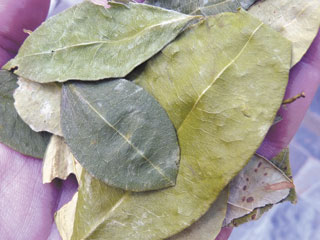Coca leaf sacred to Bolivia indigenous
By Sara Shahriari, Today correspondent
In a mineshaft in southern Bolivia a young Quechua
Indian miner scattered coca leaves at the feet of El Tio, the
devilish god who guards the entrance to the mines. In a fashionable
café in La Paz a woman sipped a pale green tea made of coca leaves,
and on the shores of Lake Titicaca a man harvesting wheat chewed the
deep green, pungent leaves as he worked a long day under the intense
sun.
The coca leaf can be processed into cocaine, but the unprocessed
leaf is deeply woven into Bolivian society. It is particularly
important to indigenous cultures, where coca has likely played key
roles in medicine and religion for thousands of years. Those uses
continue today. Miners and farm workers chew the leaf for energy,
and it’s used in religious ceremonies and traditional medicine.
Jaime Castro is an Aymara Indian coca farmer from the Yungas region
of Bolivia. “Coca isn’t cocaine in its natural state. And for us
from the Yungas coca is life, it’s clothes, it’s education.” Castro,
now in his 40s, has chewed coca since he was 14 years old. He says
his good health and sharp mind prove that the coca leaf is not an
addictive or destructive substance.
The modern history of coca in Bolivia is a complex story. During the
1990s, successive U.S. administrations tried to eradicate coca
totally in the Chapare region, but accepted growth of almost 30,000
acres in other areas, according to information from the Andean
Information Network. Forced eradication in the Chapare proved a move
that pitted U.S. policy against local organizations and created
animosity that is still alive today.
Evo Morales, Bolivia’s Aymara Indian president, rose into Bolivia’s
political scene as director of a highly organized federation of coca
growers. Morales actively defends Bolivia’s right to cultivate coca
for legal uses such as chewing, commercial products such as tea and
flour, and in religious ceremonies. Morales has called coca “the
sacred leaf” because of its importance to Bolivia’s indigenous
people.
The United Nations Office on Drugs and Crime estimates that in 2009
about 76,355 acres of coca were cultivated in Bolivia. Of those
acres about 49,420 are legally grown under Bolivian law and
considered destined for local use. In 2008, Bolivia produced 19
percent of the world’s coca leaf, behind both Peru and Colombia.
The majority of Bolivia’s legally sold coca makes its way to one of
the country’s two coca markets.
Villa Fatima, a neighborhood in La Paz, Bolivia, is home to
Bolivia’s largest coca market, where more than 17 tons of the leaves
are bought and sold each year, changing hands between producers and
wholesalers. Sacks of the dried, slightly crisp leaves sit in vast
warehouses, while others are strapped into trucks. The air smells of
the bitter-sweet leaves.
The sellers are members of ADEPCOCA, an association of Yungas coca
growers. Nicholas Chincha is a leader in the association. He said
the coca leaf is a crucial part of indigenous medicine used to sooth
stomachaches, headaches and joint pain, and to stave off hunger and
thirst. It also gives energy to laborers and helps them work more,
Chincha said.
Because of this array of properties, the coca leaf is highly valued
and used in religious rites. When offerings are made to Pachamama,
the earth mother, coca is part of the ceremony. “No other food has
the same properties as coca, and because of those properties it’s a
very powerful offering to Pachamama or the gods,” Chincha said.
“It’s sacred.”
Part of Morales’ plan to increase the legal coca market in Bolivia
is to create more legal uses for the leaf. Enter Victor Ledezma, a
passionate advocate of the coca leaf and founder of the Coca Colla
brand. This very sweet soda uses coca leaves as a key ingredient.
Ledezma hopes coca leaf products including soda, toothpaste and
flour will expand the legal market’s demand for coca leaves
considerably.
Like many coca growers, Castro hopes coca products someday become a
legal Bolivian export to many parts of the world. Castro wants the
restrictions of the United Nation’s Single Convention on Narcotic
Drugs, which make exporting the coca leaf in its natural state
illegal for countries that have signed the convention, to be lifted.
“Foreign governments demonize coca, mostly the government of the
United States. But we hope that our coca can be exported in the
future.”
While the legal future of coca exports remains uncertain, the leaf’s
place in Bolivian society is firm. Coca continues to play a key role
in indigenous life, as it has for thousands of years.
© 1998 - 2010 Indian Country Today. All Rights Reserved To subscribe or visit go to: http://www.indiancountry.com
